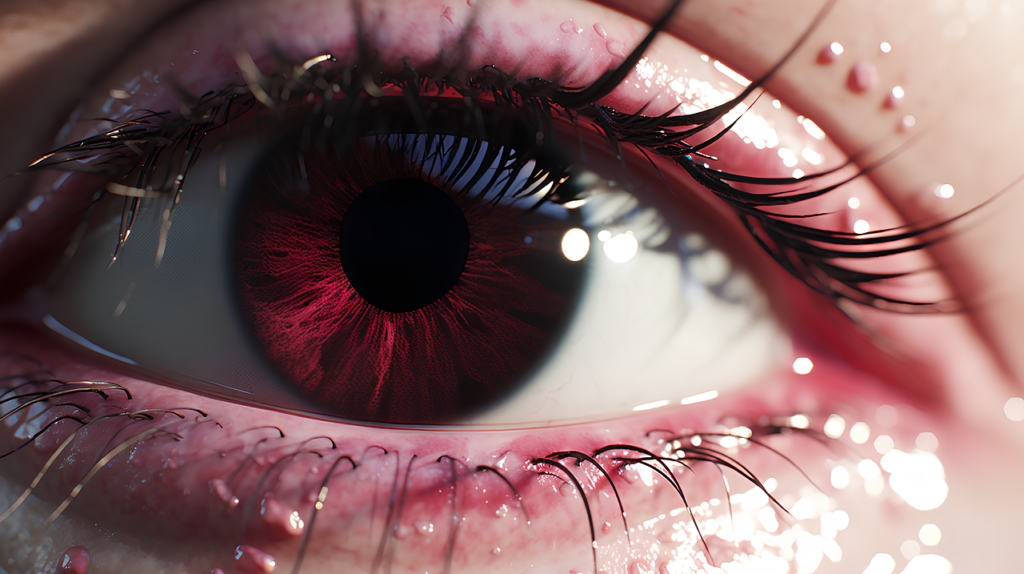Conjunctivitis, often referred to as “pink eye,” is a common eye condition that can affect people of all ages. It’s characterized by redness, itching, and sometimes discharge in one or both eyes. While conjunctivitis is typically not a severe condition, it can be uncomfortable and even contagious. In this beginner’s guide, we’ll delve into the definition, pathology, causes, risk factors, signs and symptoms, and prevention of conjunctivitis. Furthermore, we’ll explore the potential benefits of homeopathy in treating this eye condition, providing you with valuable insights into alternative therapeutic options.

What is Conjunctivitis?
Conjunctivitis, also known as pink eye, is an inflammation of the conjunctiva, the clear, thin membrane that covers the white part of the eye (sclera) and lines the inside of the eyelids. The conjunctiva helps protect the eye from foreign substances and infections by producing mucus and tears. When it becomes inflamed, it can lead to various uncomfortable symptoms.
What is the Pathology of Conjunctivitis?
The pathology of conjunctivitis involves the inflammation of the conjunctiva due to various factors, such as infections, allergens, irritants, or underlying health conditions. The inflammation typically occurs in response to a trigger, leading to a cascade of immune responses.
Infectious conjunctivitis is often caused by bacteria or viruses. Bacterial conjunctivitis is frequently associated with Staphylococcus or Streptococcus bacteria, while viral conjunctivitis can be caused by the adenovirus. Allergic conjunctivitis results from the body’s hypersensitivity to allergens like pollen, dust mites, or pet dander. Irritant conjunctivitis, on the other hand, occurs when the eyes are exposed to substances like smoke, chemicals, or foreign objects.
What are the Causes of Conjunctivitis?
1. Infections: As mentioned earlier, bacterial and viral infections are common causes of conjunctivitis. Close contact with an infected person or contaminated surfaces can facilitate the spread of infectious conjunctivitis.
2. Allergies: Allergic conjunctivitis is triggered by allergens like pollen, mold, pet dander, or dust. Exposure to these allergens can lead to an allergic reaction in the eyes.
3. Irritants: Exposure to irritants such as smoke, pollution, or chlorine in swimming pools can cause irritant conjunctivitis. This type of conjunctivitis usually clears up once the irritant is removed.
4. Underlying Health Conditions: Certain medical conditions like dry eye syndrome, autoimmune diseases, and systemic infections can increase the risk of developing conjunctivitis.
What are the Risk Factors of Conjunctivitis?
Understanding the risk factors associated with conjunctivitis can help individuals take preventive measures and seek appropriate care when necessary. Some common risk factors include:
1. Close Contact: Being in close proximity to someone with infectious conjunctivitis, such as a family member or classmate, increases the risk of transmission.
2. Seasonal Allergies: Individuals with a history of seasonal allergies are more susceptible to allergic conjunctivitis during high pollen seasons.
3. Eye Irritants: People who work in environments with exposure to eye irritants, like chemicals or dust, may be at higher risk of developing irritant conjunctivitis.
4. Preexisting Health Conditions: Those with autoimmune disorders, dry eye syndrome, or compromised immune systems are more prone to developing conjunctivitis.
What are the Signs and Symptoms of Conjunctivitis?
Recognizing the signs and symptoms of conjunctivitis is essential for early diagnosis and appropriate treatment. Common conjunctivitis symptoms include:
1. Redness: The hallmark sign of conjunctivitis is redness in one or both eyes due to inflammation of the blood vessels in the conjunctiva.
2. Itching: Irritation and itching in the affected eye(s) can be intense, especially in cases of allergic conjunctivitis.
3. Watery Eyes: Excessive tearing or watery discharge may occur, making vision blurry.
4. Discharge: Depending on the type of conjunctivitis, there may be different types of discharge. Bacterial conjunctivitis can lead to yellow or green discharge, while viral conjunctivitis may produce clear, watery discharge.
5. Swelling: The eyelids may become swollen, making it difficult to open the eyes fully.
6. Sensitivity to Light: Some individuals with conjunctivitis may experience increased sensitivity to light, known as photophobia.
7. Foreign Body Sensation: It might feel like there’s a foreign object or grit in the eye, causing discomfort.
8. Crusting of Eyelids: Bacterial conjunctivitis can result in crusting of the eyelids, particularly upon waking up in the morning.
How to Prevent Conjunctivitis?
Preventing conjunctivitis, especially in cases of infectious and allergic conjunctivitis, is crucial for maintaining eye health. Here are some preventive measures to consider:
1. Hand Hygiene: Regularly washing your hands with soap and water, especially after touching your eyes or face, can reduce the risk of infection.
2. Avoiding Eye Rubbing: Avoid rubbing your eyes, as this can introduce bacteria or irritants and worsen the condition.
3. Proper Contact Lens Care: If you wear contact lenses, follow hygiene guidelines strictly, including proper cleaning and storage of lenses.
4. Allergen Avoidance: For individuals with allergies, minimizing exposure to allergens through strategies like keeping windows closed during high pollen seasons can help prevent allergic conjunctivitis.
5. Eye Protection: When working in environments with potential eye irritants, wear protective eyewear to shield your eyes.
6. Good Hygiene in Shared Spaces: In schools, workplaces, or other shared environments, encourage good hygiene practices to prevent the spread of infectious conjunctivitis.
7. Prompt Treatment: If you suspect conjunctivitis or notice symptoms, seek medical attention promptly. Early diagnosis and treatment can help prevent the condition from worsening and reduce the risk of transmission.
The Benefits of Homeopathy in Treating Conjunctivitis
Now that we’ve covered the essentials of conjunctivitis, let’s explore the potential benefits of homeopathy in treating this common eye condition.
Homeopathy and Conjunctivitis
Homeopathic remedies for conjunctivitis are selected based on the individual’s specific symptoms, including the type and severity of conjunctivitis they are experiencing. Homeopathy aims to address the underlying causes of the condition and stimulate the body’s natural healing processes.
Here are some homeopathic remedies commonly used for conjunctivitis:
1. Euphrasia: Euphrasia, or eyebright, is a well-known homeopathic remedy for conjunctivitis with symptoms like watery discharge that burns the eyes, along with sneezing and a runny nose.
2. Pulsatilla: Pulsatilla is often indicated for conjunctivitis with yellow or greenish discharge and a burning sensation. It is also suitable for individuals who are thirstless and seek open air.
3. Apis Mellifica: This remedy is useful for conjunctivitis with swollen, puffy eyelids and a stinging, burning pain. Cold applications may provide relief.
4. Allium Cepa: When conjunctivitis symptoms are accompanied by a profuse, bland discharge and a watery nose with a burning sensation, Allium Cepa can be beneficial.
5. Arsenicum Album: Arsenicum Album is indicated for conjunctivitis with a burning, smarting pain and restlessness. It may be beneficial when the eyes feel hot and dry.
6. Belladonna: Belladonna is considered when conjunctivitis presents with sudden onset, intense redness, and a sensation of heat. The eyes may be dry and pupils dilated.
It’s essential to consult a qualified homeopathic practitioner for personalized treatment. Homeopathic remedies are highly individualized, and the choice of remedy depends on a thorough assessment of the patient’s overall health and specific conjunctivitis symptoms.

In Conclusion
Conjunctivitis, though common and often not serious, can be uncomfortable and disruptive to daily life. Understanding its definition, pathology, causes, risk factors, signs and symptoms, and prevention measures is crucial for maintaining good eye health. Additionally, exploring alternative treatment options like homeopathy can provide individuals with additional choices for managing their condition.
While homeopathy offers potential benefits in treating conjunctivitis, it is essential to approach it as a complementary therapy and consult a qualified homeopathic practitioner for personalized care. The holistic and individualized nature of homeopathy can be a valuable addition to the spectrum of treatments available for conjunctivitis, promoting overall well-being and providing relief from discomfort.
Remember that maintaining good eye hygiene, seeking timely medical advice, and adopting preventive measures are fundamental in managing and preventing conjunctivitis. Whether you choose conventional or alternative approaches, your eye health should always be a top priority.
Reach out to us for a Consultation
For any queries, reach out to us at contact@homeopathic.ai
This blog is for information purposes. It’s crucial to note that while homeopathy is a centuries-old practice with many adherents worldwide, always consult a qualified homeopath or medical professional before initiating any treatment.





